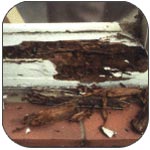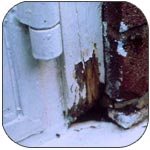Wet Rot
What is it?

Wet rot is a very common and much less serious property ‘ailment’ than some of the other afflictions that can set back your building (and your bank balance)!
It is mainly caused by a fungus called Coniophora puteana which only infects very damp wood and causes it to decay, and thereby lose strength. Unlike dry rot, wet rot is cannot spread into walls.
How to spot it
Often there is no visible fungal growth on the affected area. Wet rotten wood has a soft and spongy feel that often looks darker than the healthy wood around it. Rotten wood that has since dried out has longitudinal cracks and easily crumbles into fine dust.
If covered by paint, it can appear that wood is perfectly sound, when in fact it is rotting from the underside out. Test wood by poking it with a screwdriver; if it sinks in easily, the wood is rotten.
Brickwork, on the other hand, may be covered by a fan-like growth. This is easily removed with a wire brush.
How to fix it

Wet rot will almost always be due to some sort of structural defect which is allowing water to collect on a wooden surface, be it condensation, rainwater or water from the property’s plumbing. The first course of action is therefore to eliminate the source of water to prevent the problem becoming worse or reoccurring.
There are several routes for water ingress in a property. Be sure to check the integrity of each of the following areas, and fix the problem as soon as possible:
- Guttering and drainpipes
- Roof tiles and roof flashing
- Cracks in brickwork or walls
- Damaged, bridged or missing damp-proof course
- Blocked air bricks, poor ventilation and persistent condensation
- Cracked or broken water pipes
- Persistent overflow from water tanks and cisterns
- Flaking paint or varnish on doors, windows and their frames
Repairing the damaged area
Having removed the source of water, the rotten timbers should be removed and replaced. If this woodwork was structural (joist or roof truss) it should be replaced with new timbers that have been pre-treated with an effective preservative such as pressurisation, double vacuum methods or a 10-minute dip in an organic solvent preservative to satisfy the requirements of British Standard BS 5268. Remember to re-treat any cut-ends or joints.
If a small area has been affected, having removed rotten wood back to sound timber, the surface of the remaining wood in the vicinity should be treated with an epoxy wood hardener and preservative, before any gaps are filled.
Further information and useful links
- Find a Chartered Surveyor near you
- Find a Damp Proofing Specialist near you
- Find a Guttering specialist near you
- Find a Water Proofing Specialist near you
- Find a Masonry Repairs Service near you
Site Pages
Featured Articles





